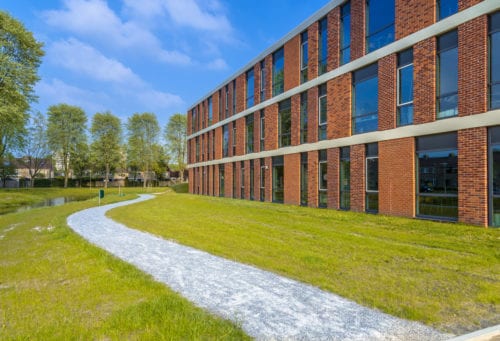Architecture detail of modern office building situated next to park with walking trail on a bright day in spring (Architecture detail of modern office building situated next to park with walking trail on a bright day in spring, ASCII, 113 components,

Going Green Just Got Easier for Class B/C Commercial Buildings
Class B/C office buildings can achieve up to 6 percent higher net operating incomes and $11 per square foot higher property values, but they can’t do it with their hands tied behind their backs. To date these buildings, relative to their typically newer and higher quality Class A counterparts, have been bound by tougher information constraints, resource constraints, and funding constraints when it comes to investing in energy efficiency and green leasing strategies. And that’s a major problem, considering that Class B/C office buildings represent an estimated 5 billion square feet nationwide. Enter Unlocking Hidden Value in Class B/C Office Buildings, a new report coproduced by Rocky Mountain Institute, Urban Land Institute, and Building Owners and Managers Association (BOMA) International. The report gives Class B/C office owners the tools and concrete ideas they need to overcome these barriers by:
- Clarifying the business case, identifying available resources, and detailing case studies
- Proposing easy low-cost strategies to improve energy efficiency
- Simplifying key components of green leases that can capture the highest-impact benefits
Grounding the report in real world examples, the authors collected insights from over 20 Class B/C real estate industry stakeholders. These insights are included throughout the report, serving as proof points that energy efficiency and green leasing strategies can be applied in the Class B/C market to a much greater extent.
Investing in Efficiency
Compared to business-as-usual operations, Class B/C properties could save roughly 15 percent of their energy costs with a bundle of low- to no-cost measures, and 35 percent or more with larger investments. That can translate into net operating income increases of 2.4 to 5.6 percent, and property value increases of $5 to $11 per square foot (i.e., $343,000 to $800,000 for a 75,000 square foot building) with key green lease provisions in place.
Realizing that value potential starts by understanding the available educational resources and low-cost, easy-implementation opportunities. Many organizations and associations, including ULI and BOMA International, offer trainings and webinars. Local chambers of commerce and small business associations may also offer educational and financial resources for owners. Energy benchmarking is an easy way to identify trends that help owners understand how usage and costs change overtime. Energy audits can identify cost-effective efficiency improvement opportunities. Existing equipment can also be optimized through preventative maintenance and retro-commissioning, which can lengthen lifespan, improve efficiency, and reduce costs. For more capital intensive measures, Class B/C stakeholders can seek local utility rebates and incentives, leverage Commercial Property Assessed Clean Energy (C-PACE) financing, and/or bundle efficiency measures at key building renovation or replacement points.
Implementing Green Leases
In support of efficiency improvements, integrating green lease provisions can enhance property value and align tenants around a building culture that advances sustainability goals. Green leases can improve the economics of energy efficiency projects for owners and signal to new and prospective tenants a commitment to value optimization.
Class B/C building owners should include language in standard form leases establishing a range of low- to no-cost strategies that improve energy management practices and ensure transparency. Landlords should also include lease language that establishes minimum efficiency standards for tenant fit-outs (e.g., installing LED lighting, EnergyStar certified appliances, and/or plug load controls). Tenants will likely be open to these kinds of requirements given their potential to reduce occupancy costs. Lastly, energy project cost recovery provisions allow owners to recoup the upfront cost of efficiency improvements, particularly capital-intensive ones, by fairly amortizing costs back to tenants over time and thereby aligning the costs and benefits of energy upgrades.
Unlocking the Hidden Value
There is no reason for Class B/C buildings to remain inefficient and more costly to operate. Class B/C building owners can overcome day-to-day management burdens, limited staff, and smaller budgets by focusing on easy low- to no-cost efficiency strategies in one hand and green leases in the other. The potential for Unlocking Hidden Value in Class B/C Buildings through this combination has never been higher, and it’s due time that the Class B/C market starts catching up to Class A.
Interested property owners and managers who want to learn more should stay tuned for an upcoming ULI- and RMI-hosted webinar later this winter to dive deeper into the discussion (details to be posted here).

